Keeping track of complex programs with countless subprojects is a challenging and demanding task for professionals. With the right methods and tools, advanced and powerful program management will help you keep track of everything important at all times. This article provides 8 recommendations and a program management example, which will help you when implementing and improving your environment. These include:
- Differentiation between program management and other terms
- What are program management tasks?
- Tip 1: Establish a program management office / program office
- Tip 2: Define the control processes
- Tip 3: Communicate how this program differs from others
- Tip 4: Define the work breakdown structure
- Tip 5: Define the interfaces between the projects
- Tip 6: Implement an efficient PPM system
- Tip 7: Automate the synchronization between the interfaces
- Tip 8: Establish an early-warning system
- Program management example: R&D in the Electronics Industry
- Conclusion
But before we get into the details of successful program management, let us take a closer look at important terms in program management. We need to clarify them to avoid possible misunderstandings.
Let us start!
Differentiation between Program Management and Other Terms
Program Management Definition
Program management involves multiple interdependent projects. All projects in a program serve to achieve one overall goal. So, we can define a program as a master project with many subprojects.
Special Download: 8 Tips for Successful Program Management (PDF file)
Profit from 8 expert tips, which will help you when implementing and improving your program management environment. Please fill in the form.
* Required Fields | Data Protection
Differentiation from Multi-Project / Project Portfolio Management
The term multi-project management, in contrast, refers to projects of one organizational unit that are implemented concurrently (e.g., IT projects that are independent from one another).
There is yet another difference: Project portfolio management, in German-speaking regions, generally defines the higher-level strategic direction of the programs and projects.
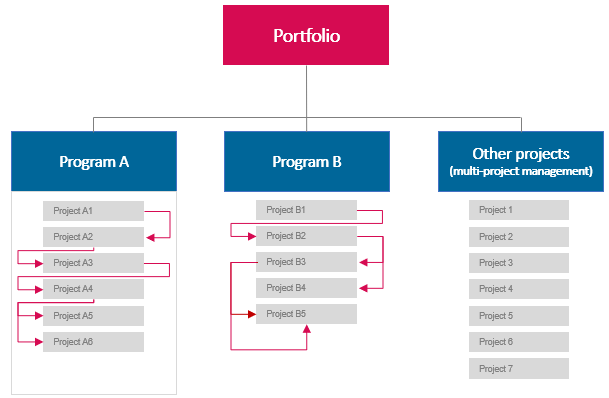
Note: Worldwide, there are differing definitions of the terms “program management” and “multi-project management”. Outside the German-speaking region, the terms “program management” and “project portfolio management” usually stand in for “multi-project management” (which causes confusion in the German-speaking regions).
What Are Program Management Tasks?
The program manager / program director is responsible for a program, consisting of several subprojects within the framework of the program. This person is often simultaneously head of the project office and / or program management office (PgrO). Program management tasks, which program managers handle with their team’s support, are the following:
- Defining programs to achieve strategic goals
- Launching projects for the program
- Defining interfaces
- Evaluating the proposed projects
- Approving, deferring, or rejecting project requests
- Monitoring projects from the client’s perspective
- Aligning schedules
- Managing cross-project information
- Coordinating resources
- Overall risk management
- Joint change control
- Managing the project marketing
- Handling quality management
Program Management according to the PMI
According to the standard of the Project Management Institute (PMI), program management tasks for the program manager / coordinator include among other things:
- Leading the overall program
- Coordinating activities within the program to keep it on track
- Working closely with the Chief Product Owner (CPO) and Chief Architecture Owner (CAO) to guide the overall work of the sub-teams
- Facilitating discussions between the CPO and CAO when there are differences.
Now that we understand the terms, let us look at the eight key tips for successful program management.
Tip 1: Establish a Program Management Office / Program Office
Programs must be carefully controlled. Due to their complexity and scope, this requires the support of a centralized responsible entity: the program management office.
The program management office (PgrO) generally has several members. Normally, you need more than one program manager to handle all the demands.
The program management office’s responsibilities can involve:
- Defining and communicating the unique characteristics of each program
- Training project managers specifically for the program at hand
- Supporting project managers in managing the projects
- Calling for the activities and data needed in preparation for the regular status meetings
- Ensuring the data quality of the projects
- Preparing reports for different committees
- Developing scenarios for problem situations
- Preparing and conducting status meetings
- etc.
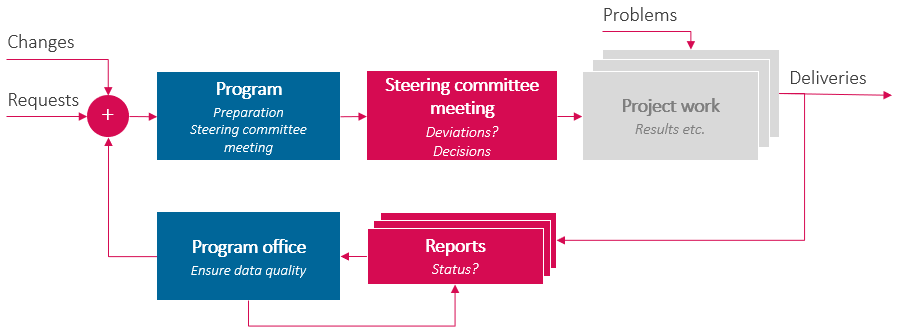
Differentiation from the PMO: Do not confuse the program management office (PgrO) with the Project Management Office (PMO). The PMO serves as a centralized control unit for managing projects throughout the company or in individual departments (such as IT-PMO). It handles activities such as the development of project standards, project monitoring, project support, training / coaching, quality assurance, and possibly even involvement in strategic decisions regarding the portfolio.
Special Download: How to setup a PMO in 4 simple steps (PDF file)
Please fill in the form.
* Required Fields | Data Protection
Tip 2: Define the Control Processes in Program Management
Firstly, ensure that the control of individual projects works at your company. Only then will your program management also run smoothly.
Before you can control an extensive program, you need to be capable of simultaneously handling a huge amount of information from individual projects. It therefore requires significant effort to prepare for a steering committee meeting. You need more preparation time, and everything needs to be better organized than with ‘normal’ projects.
Define regular intervals for the dates of the steering committee meetings. All information must be accurate, reliable, and comprehensive ‒ and ready on time for the meeting.
The meeting intervals should be relevant to your program’s time frame. This lets you identify any deviations, determine what actions are necessary, and communicate these to the relevant people / entities to ensure the program’s success.
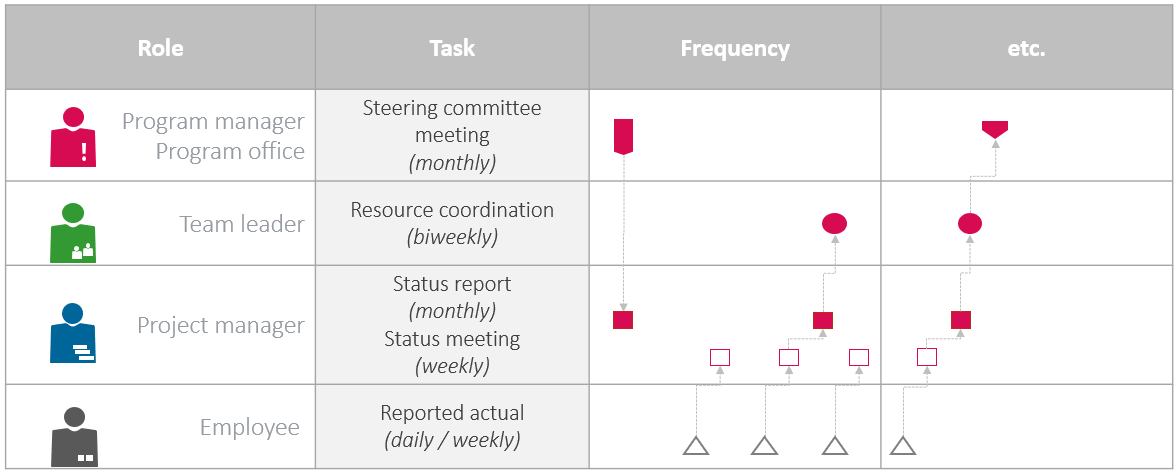
Tip 3: Focus Attention on this Program’s Unique Characteristics
Perhaps you already have a project management office (PMO). This office is usually responsible for the project management standards and project manager training (see box above).
To learn more, read this: Successful PMO setup in 4 simple steps.
However, each program is handled a bit differently. This is especially true when they involve external people and entities. It is generally necessary to define special guidelines for each individual program. Some of these guidelines will probably differ a bit from the standards set by the PMO for projects at your company.
So, make sure that every project manager is familiar with the guidelines of the respective program and agrees to comply with them.
Tip 4: Define an Appropriate Work Breakdown Structure
It is important to have an appropriate work breakdown structure for each project. This must allow program management to depict the interdependencies between the associated projects with regard to content and time frame. To achieve this, you must define the important milestones for each project. These milestones are later used to monitor the program.
We also recommend that you create a separate master project for the program. This program plan should contain all the control information. All the interfaces or partial deliveries should converge and be controlled from here.
Our tip: Remember to create a master project for high-level information such as major milestones, etc. to simplify the monitoring and control.
With the right business solution, you will only need to open and edit one single project plan in the steering committee.
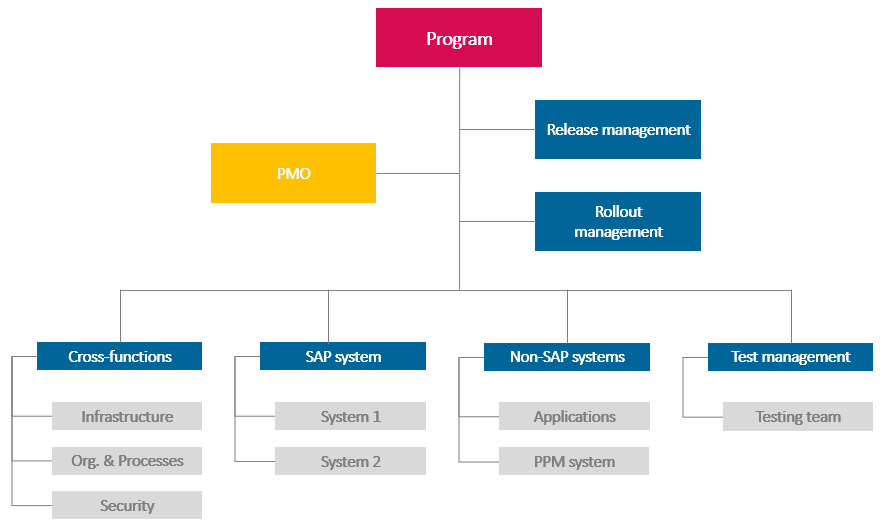
Read this article to find out more about the work breakdown structure.
Special Download: 10 Vital PMO Success Factors (PDF file)
Please fill in the form.
* Required Fields | Data Protection
Tip 5: Define the Interfaces between the Projects
Based on the aforementioned clear project structure with milestones, the steering committee regularly issues its targets. These targets are assigned to the corresponding projects (top-down), and the project managers are then responsible for meeting these targets.
Conversely, the current milestone dates have to be collected from the projects on a regular basis (bottom-up). Suitable program management software can ensure an easy-to-read presentation. The subsequent Tip 6 further elaborates on this software support.
The discrepancy between planned dates and the actual dates of the interfaces determines the necessary degree of centralized control by program management.
TPG’s PMO Survey conducted in the DACH region in the year 2020 determined the status of PMOs from 330 companies. It came to the conclusion that managing cross-project interdependencies in the multi-project or program environment was one of the most important duties for successful PMOs. Top-performing companies were clearly ahead of low performers in this respect. These findings probably also apply to program offices.
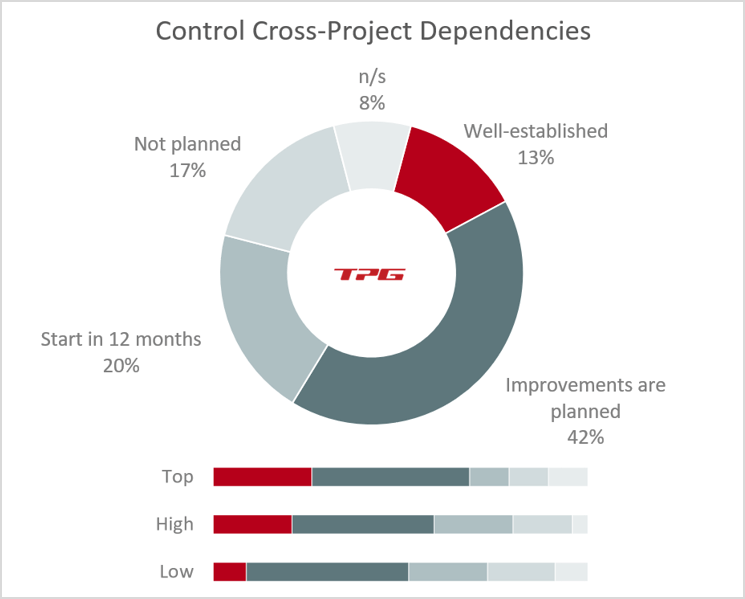
Tip 6: Use a Good Program Management Software
A strong multi-project tool / program management software is needed for successful program management and to manage complex programs. Many suitable products are currently on the market, and these have become ever more sophisticated over the past few years.
For successful program management, we recommend a solution that enables you both top-down and bottom-up control of your projects as described above. The determining factor is how it lets you define the links between the projects.
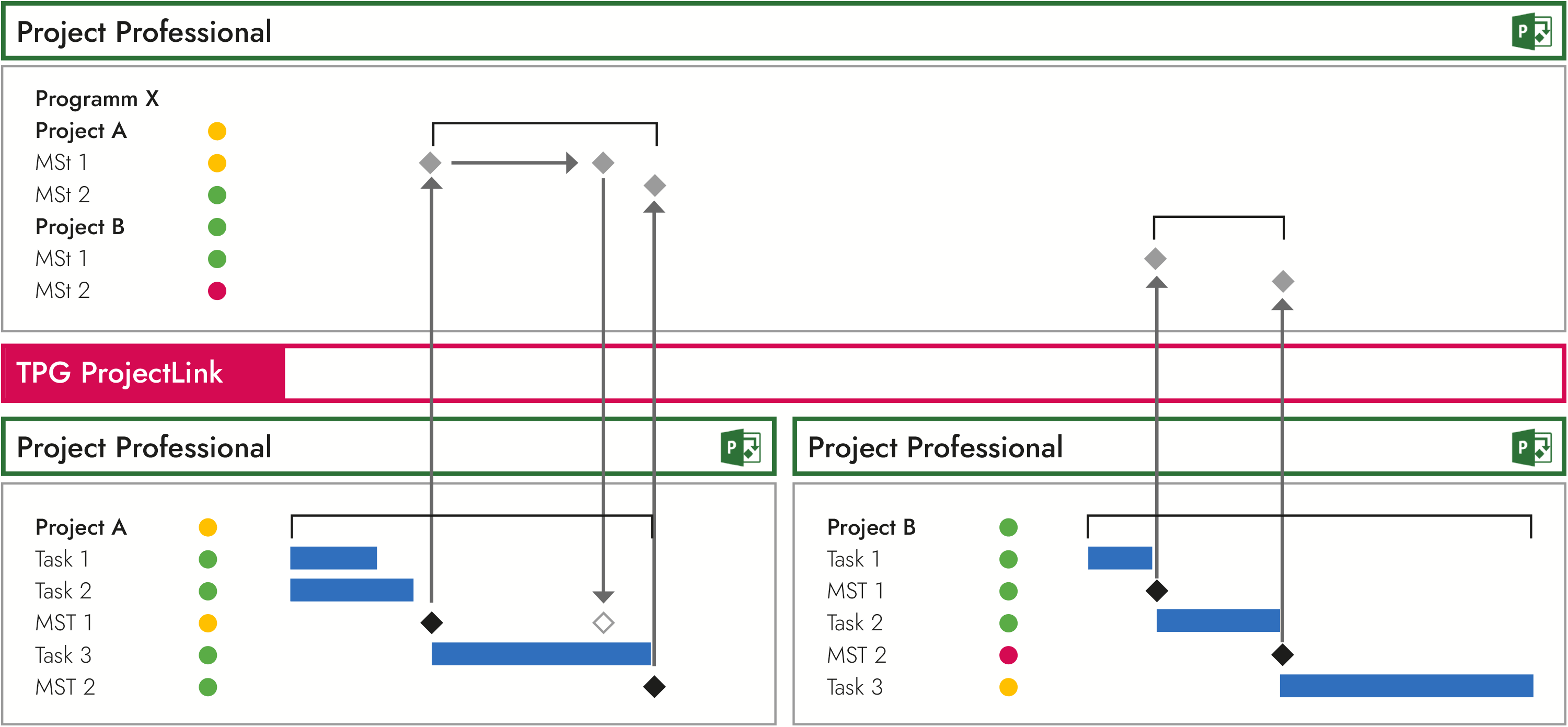
You want to avoid a scenario in which you open the solution and immediately see all the changes related to linked tasks but cannot view the previous status for comparison, because you then might not be able to see exactly what has changed.
The ideal solution would let you view the schedule and simply click to display the external milestones. This would let you view your program plans and links simultaneously, and you could easily modify your plans.
Tip 7: Set Up Automatic Synchronization of the Interfaces
In program management, automatic synchronization with the program plan saves you a lot of time when project deadlines are postponed. Ideally, you would be able to simply open the program plan and immediately see the current status of every milestone alongside its planned status (cf. figure in Tip 6)
If you have numerous interfaces:
- A solution like this can save you a lot of time
- You can concentrate fully on managing the program
- You are no longer wasting time gathering the latest data, which will soon be out of date again
Using the appropriate integration middleware software enables you to combine various software tools from different sub-projects. This is useful for large-scale programs involving diverse suppliers in sectors such as the aerospace industry. You can use Primavera while others use Planisware or Microsoft Project Server / Microsoft Project Online or the advanced TPG ProjectPowerPack.
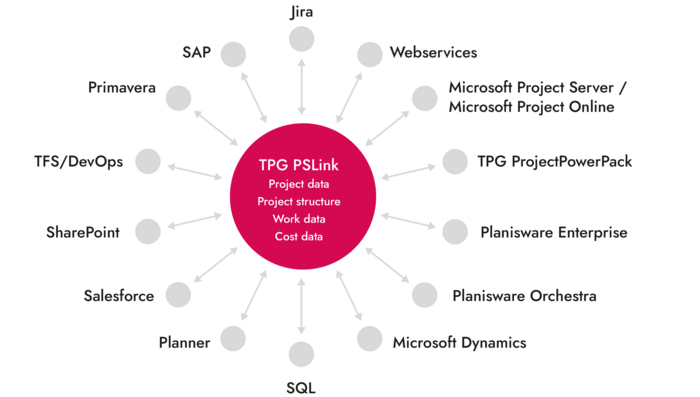
Tip 8: Establish an Early Warning System
Do not rely only on the currently reported dates when managing the interface deadlines. Use the Milestone Trend Analysis (MTA, e.g., this free Milestone Trend Analysis for Microsoft Project) for successful program management. For the most important interfaces and deliveries, you will receive an early warning with this tool, alerting you if dates are frequently being rescheduled.
Our tip: Use the program plan’s targets as target dates for important project milestones in the MTA. This enables you to easily identify the critical effects of any delays or postponements.
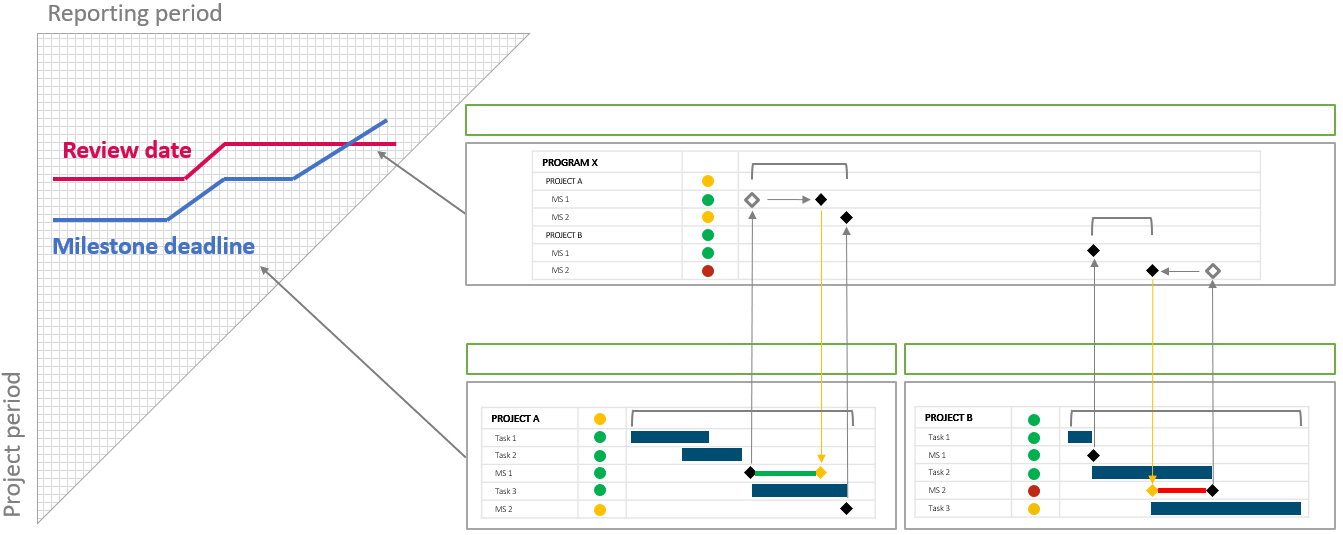
A Program Management Example: R&D in the Electronics Industry
The complexity of programs becomes clear when looking at the electronics industry. In this field, you have to coordinate features and releases across sub-projects. Below, we describe this example of program management with its challenges in more detail and give practical tips for the implementation.
Characteristics of Products in the Electronics Industry
In the electronics industry, the product to be developed tends to consist of many different hardware and software components. Various teams develop these components separately. At the end, they are integrated.
On the other hand, development and integration do not take place in one go with the complete range of functions. They are carried out step by step across several development and delivery stages with defined functions across all components.
A program starts with the specification of features that make up the utility of the electronic device. For instance, a mobile phone includes an alarm clock an internet browser, and WLAN. Music playback is also possible.
A release plan defines:
- which feature will be provided or tested
- in which development stage or
- in which intermediate release.
Some product developments have release plans with several hundred features. Their fifty or more delivery dates extend over a year or more.
One feature usually affects several components built in different teams. That is the underlying reason for the complexity.
For instance, the mobile phone alarm clock requires a user interface to set the time. The set time needs to be saved and registered as an event. At the appointed time, the loudspeakers have to produce one of the selected melodies.
This means: an intermediate release with a working alarm clock will affect at least five or six components. Overall, you may have a hundred components developed by twenty teams. These teams have to deliver their joint contributions by the planned release dates.
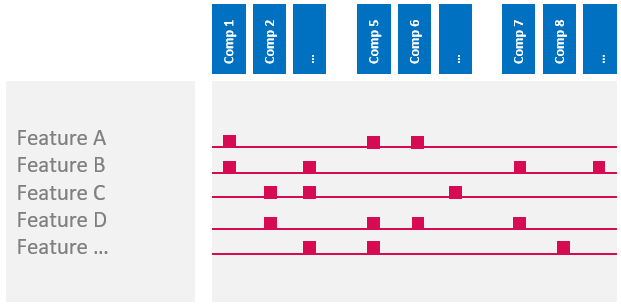
Challenges in Program Management
The affected teams are increasingly scattered all over the globe. They are allocated to their company’s programs according to their skills.
For this, you should use a work breakdown structure reflecting the responsibilities. Hence, components are planned in separate sub-project or component plans structured by features.
Our tip: Plan your components in separate component plans structured by features. This will help you keep things in view.
The sub-project manager is usually also responsible for the assembly or component. Some companies have feature managers on top of this. The latter have the responsibility to plan and control the implementation of a feature across all components and releases.
The Challenge of Program Resource Management
The complex dependencies pose a constant challenge for resource management.
Whenever component delivery dates shift, this has repercussions. The related test or integration task in another sub-project needs to be rescheduled, too. However, you will not want to do the resource planning for individuals at the level of the program.
Better arrangement: the program manager and the sub-project managers agree on deliverables.
Our tip: Agreeing on deliverables supports the cooperation between program and sub-project managers.
The result is that you do not plan resources at program level. All you plan are contents and target dates in the form of milestones. Naturally, these arise from the availability of resources in the sub-projects. Again, the sub-project managers control this availability.
Check out this article: Project Resource Management – Basics and Areas
Establishing a Control and Early-Warning System
First, you have to design the central release plan for the steering committee well. On the one hand, you should match the releases and the increments of the deliverable features.
After all, you want to have an overview showing:
- all deliveries required for one release
- from all components affected
It should tell you if all partial deliveries from the component will plans take place by the planned release date.
Design your component plans accordingly. You want one standardized completion milestone per feature and release.
Our tip: Central for component plans: one standardized completion milestone per feature and release.
You have to roll out the targets from the release plan to these milestones. Vice versa, the actually planned dates need to be reported back to the release plan.
Our tip: Sub-projects should not be linked to each other. The linking should occur solely via the release plan. This permits the steering committee to check the dependencies and scheduled dates at any time.
This is the only way to implement an efficient control and early-warning system for program management.
Bottom-Up and Top-Down Communication in Programs
A suitable software solution highlights the differences between the target and the actual situation in both
- the release plan and
- the component plan.
To achieve this, milestones from one plan are displayed in the other plan.
In the image below, the steering committee can see a variance: Release 1 will include an early completion of Component 1.
The situation is different for Release 2. This time, the plan for Component 1 reports an exceeding of the target date to the program manager’s release plan.
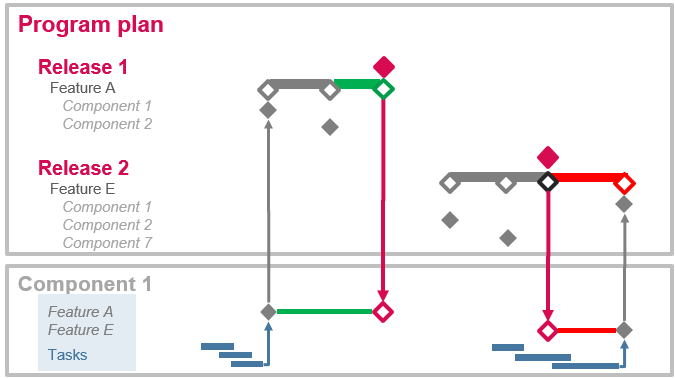
Clear Data Responsibilities and Time Saving
A bidirectional program management solution is clever for one reason. Neither party alters the data of the other. The milestones are displayed in the other plan at the push of a button. This is for information only.
The information serves as a basis for communication between the responsible parties. Thereupon, both parties can change their own plan. All project managers remain in charge of their own respective plan. Neither their own nor anybody else’s data is changed. This is paramount for the acceptance of a software solution. In addition, this method saves time, since the communication becomes much more target-oriented.
Our tip: Use project management software that provides information without changing the data structure of the other roles.
This ping-pong game between top-down and bottom-up communication between the levels is an key success factor in program management. The appropriate software can provide the vital IT support.
Conclusion – Successful Program Management
This article has introduced you to the concept of successful program management and shown how it differs from terms such as multi-project management and project portfolio management.
It has also given you 8 tips for successful program management.
- Establish your own program management office / program office with specific tasks. This includes aspects such as communicating the program, supporting the project managers, preparing reports, etc.
- Control is essential: make sure that program management processes for managing individual projects and handling steering committee meetings are clearly defined and adhered to.
- Use your PMO to communicate the program’s unique characteristics.
- Determine the appropriate work breakdown structure for each project and remember to create a separate master project for the program.
- Ensure that there is consistent top-down and bottom-up communication to communicate the targets and current milestone dates.
- Implement a strong PPM system to support you in this effort. Make sure it allows you to set clear links between the projects.
- Become more efficient and up to date by automating the synchronization of individual dates with the program plan.
- The ability to react quickly can be crucial. Use the Milestone Trend Analysis to stay up to date about dates that are rescheduled frequently.
Lastly, a program management example from the electronics industry has shown you how to:
- Start programs using feature and release specifications
- Coordinate teams or components via a work breakdown structure
- Facilitate the collaboration between program and sub-project managers
- Establish a control and early-warning system
- Optimize the communication within the program using the appropriate software.
Our final tips:
Get to know the individually adaptable “PPM Paradise” – the optimal environment for your enterprise-wide project, program, portfolio and resource management (PPM). Download the free eBook “The PPM Paradise” now (just click, no form).
And sign up for our bi-weekly blog newsletter with information on more hands-on articles, eBooks, etc. to improve your project management maturity level.
What has been your experience with program management? Is there a critical success factor that you feel we have missed? Please let us know in the comment area below.
Subscribe to TPG BlogInfo: Never miss new practice-oriented tips & tricks
Every other week: Receive practical tips in TPG blog posts written by recognized experts in project, portfolio, and resource management.
* Required Fields | Data Protection
 Johann Strasser
Johann Strasser
Managing partner at TPG The Project Group
The certified engineer has been a managing partner at TPG The Project Group since 2001. After many years as a development engineer in the automotive and energy sectors, Johann Strasser spent a decade as an independent trainer and consultant in the field of project management. During his tenure, he also served as project manager for software projects in the construction industry and provided scheduling and cost management support for large-scale construction projects. At TPG, he applies his expertise in product development and consulting services for international clients. His special focus is on PMO, project portfolios, hybrid project management, and resource management. For many years now, he has shared his knowledge through presentations, seminars, articles, and webinars.
 Achim Schmidt-Sibeth
Achim Schmidt-Sibeth
Senior Marketing Manager
After earning his engineering degree in environmental technology, he gained many years of experience in project management through his work at an engineering office, an equipment manufacturer, and a multimedia agency. Achim Schmidt-Sibeth and his team have been responsible for marketing and communication at TPG The Project Group for many years now.


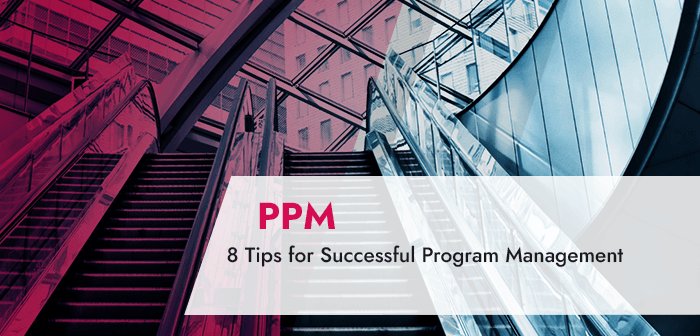






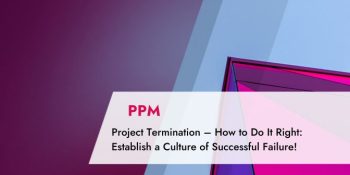
6 Comments
A truly great blog, love the information you provided on startup success factors!
Thank you very much Aaron. Keep on recommending the blog in your network 😉
Best one yet
Dear Nina,
thank you very much! Feel free to take a look at our other articles.
Have a great day!
Anna Pauels
Thanks for the article, really great insights on creative project management, especially loved the tip about an early warning system.
Thanks for the article thie will help us to improve our ability in management of whatever project in the production